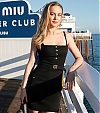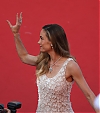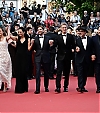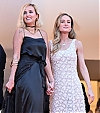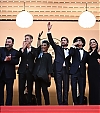Brie Larson Is Ready to Kick Some Ass
It was a tad surreal waiting for Brie Larson at a dimly lit, rustic Italian restaurant in Beverly Hills. I’m a Marvel comic-book editor, as well as the co-creator of Kamala Khan, a Muslim-American hero whose idol happens to be Captain Marvel, the very role that Larson, 29, is playing in movie theaters around the world this month. Meeting the star of Marvel’s first female-led superhero film felt, well, a touch meta.
As far as hero origin stories go, Larson’s began quite early. She says her first “Aha!” acting moment came when she played the Energizer Bunny at the age of 4 during her family’s Christmas talent show. “At one point I had to walk across the living room in the costume, and my whole family laughed,” Larson says, smiling. “I didn’t know that was something that could happen, and I didn’t understand why it happened, but I liked it.”
As a young girl, she would pull at her mother’s shirttails in her childhood home in Sacramento, Calif., to tell her it was her “dharma” to be an actress. “It was a way of learning how to be a person,” recalls Larson, dressed in a black sweatshirt, a jeweled choker, and jeans as she sips a Campari cocktail. “This is how you make eye contact. This is how you talk. This is how you hold a conversation. This is how you connect with your feelings. This is how you express yourself. I’d be in a completely different place if I hadn’t found acting so early on, because I think I really would have found comfort in my extreme shyness.”
At the age of 6, Larson enrolled at the American Conservatory Theater in San Francisco to study drama. She was the youngest student ever to be admitted.
This determination has stayed with her throughout her career. With her supporting roles in 21 Jump Street, The Spectacular Now, Don Jon, and Showtime’s United States of Tara, there’s a good chance you’ve watched something with Brie Larson in it before you even knew who Brie Larson was. She’s been behind the camera too, writing and directing films like The Arm and Unicorn Store.
By the time Larson had won the best-actress Oscar for Room in 2016, at the age of 26, she discovered she was as vulnerable as she was driven. The morning after the awards, she called her pal Jennifer Lawrence in a state of bewilderment. “I was like, ‘I don’t feel any different. I don’t feel better about myself. I still don’t feel like I’m a good actress,’ ” says Larson. “She was like, ‘Oh, yeah. That’s totally normal. I’ve had the same thing. Don’t think of it like that. Think of it as, like, you got your Ph.D. You’re certified; that’s it. It doesn’t change anything. You can still fuck up. Every judge is still human.’ ”
Part of the reason Larson took on the role of Marvel’s ultimate feminist icon, Captain Marvel, is due to the character’s own sense of humanity. “She didn’t apologize for herself,” Larson explains. “I felt like that was a really valuable trait, because she is incredibly flawed and makes a lot of mistakes … and has to ask to atone for them, and that is super valuable. She’s not ever shrinking herself down.”
It also linked back to her mission of filmmaking with a purpose. “The movie was the biggest and best opportunity I could have ever asked for,” Larson says. “It was, like, my superpower. This could be my form of activism: doing a film that can play all over the world and be in more places than I can be physically.”
While she felt immediately drawn to the role, making the decision was challenging. Larson was sworn to secrecy about the offer and felt she had to make the decision in a vacuum; she was even too nervous to seek her mother’s advice. Her first wardrobe fitting might as well have been done under a cloak of invisibility. “It was very weirdly emotional, and I just kept thinking, ‘Oh my god. Am I going to be a Disneyland character?’ ” (She is. There’s a Captain Marvel already on the Disney Cruise.)
To understand the significance of this role, here’s a swift lesson in Marvel history. Captain Marvel, whose civilian identity is Carol Danvers, had been known as Ms. Marvel since 1968. In 2012, Ms. Marvel’s bathing-suit-like attire was revamped into a red, blue, and gold uniform that alludes to Danvers’s Air Force background, and she was reintroduced to audiences as Captain Marvel. As Marvel’s vice president of creative development Stephen Wacker puts it, “She is Earth’s mightiest hero. Period. Not Earth’s mightiest female hero.”
As the editor of the Captain Marvel comic, I witnessed firsthand how the audience transformed around Danvers’s re-imagining. A contingency of superfans coined the Carol Corps celebrated the change as a sign that comics were becoming more welcoming to female audiences. Two years later it was announced that Captain Marvel would be a stand-alone film. For fans and those of us working there, it was an emotional and historic moment. For Larson, it was a role she had unknowingly waited for her whole life.
Larson compares it to seeing Indiana Jones for the first time when she was young. “I remember losing my mind,” she says. Harrison Ford’s character became her ideal. “I couldn’t think of a female equivalent,” she says. “There was Sigourney Weaver in Alien, of course, but there wasn’t enough of that spectrum of confidence and sass and a little bit of a mess, just a mix of everything. Women weren’t allowed to do that.” When she got the first draft of the Captain Marvel script, she had finally found her female Indy.
Saving the universe would take a great deal of preparation. Larson endured intense physical training for nine months and was eventually able to dead-lift over 200 pounds and hip-thrust over 400 pounds. (There’s video proof on Instagram of the latter, after which she drops the weights and scarfs down a cookie.) Larson even pushed her trainer’s Jeep up a hill. “The movie is not really going to look any different with the fact that I can actually lift 225 pounds. It doesn’t matter to anyone else, but it did to me,” she says with a sense of pride. “Breaking that boundary of what it means for a woman to be muscular and strong and own your body and use it as a tool, that felt meaningful.”
Larson’s training wasn’t all physical. To round out Danvers’s character, she met with members of the U.S. Air Force. “Her focus, ambition, and humor all come from the pilot in her,” says Larson. And then there was the mental preparation: To navigate the impending pressure of potentially becoming a global icon, Larson got some simple advice from Marvel’s Captain America, Chris Evans. He told her that he viewed the hoopla surrounding the role (billboards! superfans! merch!) as if it were “happening to someone else.” Larson has taken that to heart and now responds to seeing herself on toy packaging with a healthy disconnect. “I don’t think, ‘Look, that’s me!’ I think, ‘Oh, that’s odd.’ ”
Yet Larson wants to keep a bit of Captain Marvel with her: “I want to hold on to the cockiness and the sense of ownership,” she says. “Because I do believe in my abilities, and I do value myself, and I do know that I’m strong, and I do know that I can do a lot of things that people don’t think I can do.”
And what she can do is make an impact. Much of her drive these days is using her celebrity as a platform to push for social change. She is heavily involved in the Time’s Up movement, was one of the first actors to adopt an inclusion rider in her contract (mandating diversity in casting and production staff), and is a vocal advocate for representation in the media. As she begins her global Captain Marvel press tour, she has pledged to spotlight other women behind the scenes, insisting on gender and racial parity in the press and wearing mostly female designers. “Inclusion has to be a choice; it’s not happening naturally,” Larson says bluntly. “You really have to fight for it.”
To that end, Larson has high hopes to make that vision a reality. “My next goal is to start a school to train people in various jobs,” she says. Realizing the breadth of positions on a film set, she wants to create a channel of equal opportunity through a vocational program. “There are so many great jobs. You like the weird alien blasters? You could be the one who makes them. We need young people to carry on this tradition in moviemaking, and it would be so great if we had more diversity coming in through that.” She believes that if a studio can buy into the program, she can help facilitate a clear pathway and start building a more representative creative experience. “I don’t want to be successful surrounded by a bunch of people who look like me. That doesn’t feel like success at all.” She’s already started with her upcoming film, Just Mercy. It’s one of Warner Bros.’ first movies to implement her and co-star Michael B. Jordan’s inclusion riders. “I had been acting for 20 years … and it was the first time I had [a majority] of people of color on my team,” she says.
With everything Larson is dedicated to, I wonder how she manages it all. “Balance is sort of a ridiculous concept,” she counters. “It’s not like you find balance and you’re done. You’re always trying to find it.”
So she takes a more simplistic approach. She prefers Levi’s to Balmain, takes hikes with her mother, and is teaching herself how to knit. Instead of glam-ridden selfies, her Instagram is strewn with inspiring quotes and snapshots of friends. She’s also very real about what she can handle and what she’s afraid of.
“I don’t think you overcome self-doubt,” she says. “I think it’s something you listen to.” She listens, sometimes has a meltdown, and then orders Postmates. She’s realistic and fallible but undeniably persevering.
As we finish our evening, I ask Larson if she is satisfied. Probably not, she admits. She still has a lot to do, like writing more screenplays. “But I do feel satisfied eating all that pizza.”
Source : InStyle

GALLERY LINKS:
Magazine Scans > Scans From 2019 – InStyle (US) – March


